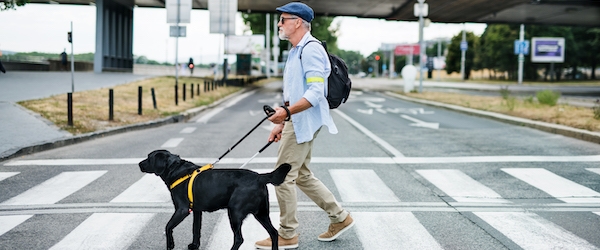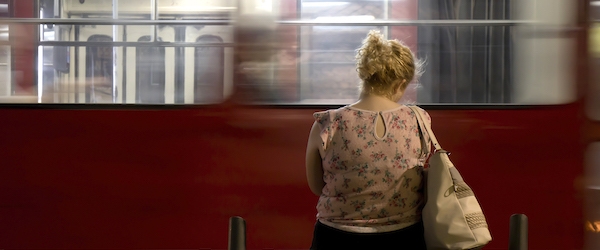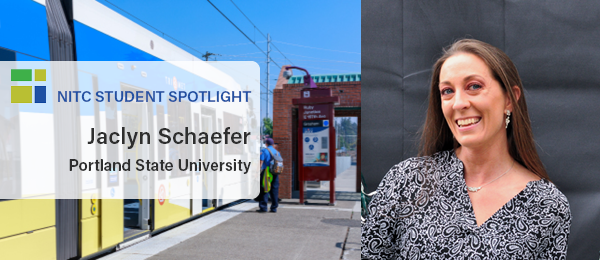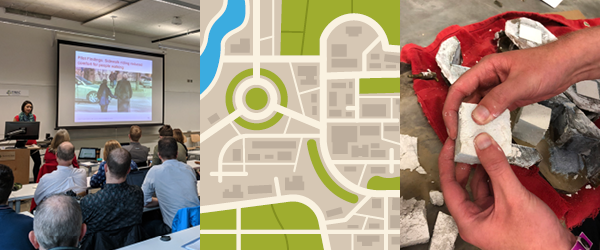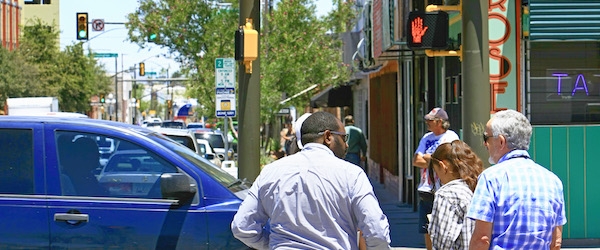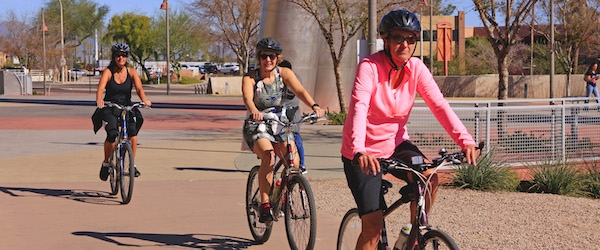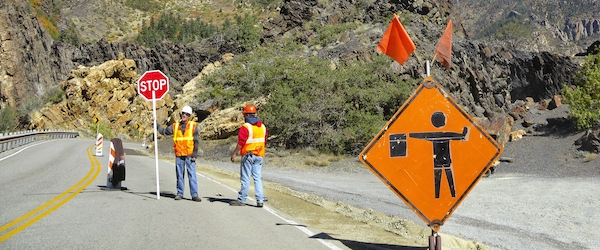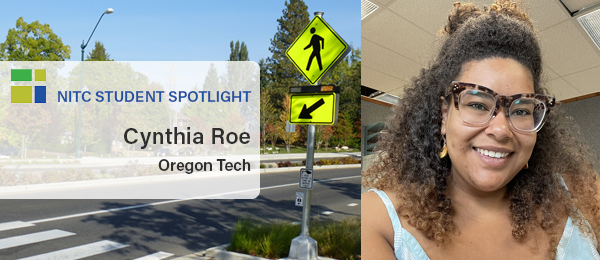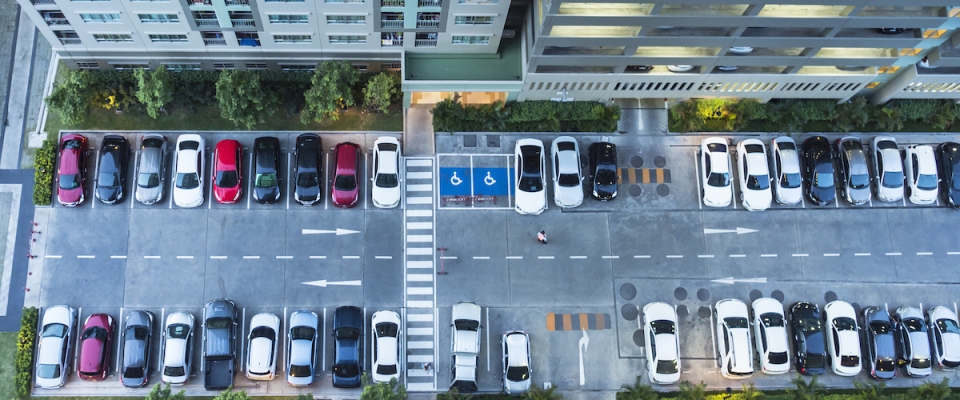Portland State University researchers Martin Swobodzinski and Amy Parker, with student co-authors Julie Wright, Kyrsten Hansen and Becky Morton, have published a new article in Frontiers in Education: "Seamless Wayfinding by a Deafblind Adult on an Urban College Campus: A Case Study on Wayfinding Performance, Information Preferences, and Technology Requirements."
The article reports on an empirical evaluation of the experience, performance, and perception of a deafblind adult participant in an experimental case study on pedestrian travel in an urban environment. The case study assessed the degree of seamlessness of the wayfinding experience pertaining to routes that traverse both indoor and outdoor spaces under different modalities of technology-aided pedestrian travel. Specifically, an adult deafblind pedestrian traveler completed three indoor/outdoor routes on an urban college campus using three supplemental wayfinding support tools: a mobile application, written directions, and a tactile map.
Results indicate that wayfinding performance and confidence differed considerably between the three wayfinding support tools. The tactile map afforded the most...
Read moreWhat is the relationship between access to transportation and our own perception of physical health?
That's the question researchers explored in the latest report funded by the National Institute for Transportation and Communities (NITC), "Examining the Impact of Transportation- Related Barriers on Self-Perceived Physical Health among Adults in the United States." Specifically looking at household car ownership, the study found that having access to a vehicle correlated with better self-reported health.
Among the other modes, respondents who used buses or paratransit were more likely to report their physical health as poor, while those who walked, biked or rode the train were more likely to report better physical health.
THE RESEARCH
The National Household Travel Survey (NHTS), conducted every 5 to 7 years by the Federal Highway Administration, is the primary source of information on the travel behavior of the American public. In 2017 the...
Read moreJaclyn Schaefer is a graduate of the civil engineering master's program at Portland State University. A former Dwight David Eisenhower Transportation Fellow, she is now a Transportation Engineer 2 in training at the Washington State Department of Transportation. During her time at PSU, Jaclyn worked as a graduate research assistant on various projects with Dr. Miguel Figliozzi. At the 2020 TRB Annual Meeting, she presented the results of a study examining how the presence of bicycles on roads without bicycle lanes affects passenger vehicle travel speeds. Jaclyn was awarded NITC scholarships during both the 2018/19 and 2019/20 academic years.
Connect with Jaclyn on LinkedIn
Tell us about yourself?
I am a recent graduate from Portland State University, where I received a MS in civil and environmental engineering, and previously completed a BS in civil engineering. During my time as a graduate student at PSU, I was fortunate to work under Dr. Miguel Figliozzi conducting research on factors affecting traffic speeds and speed limit compliance on roads with a high percentage of bicycles (an ODOT research project with co-PI Avinash Unnikrishnan) and studying the spatial distribution of...
Read moreThe National Institute for Transportation & Communities (NITC) research consortium, led by Portland State University, introduced a new grant this year. With the extension of the FAST Act, we received one more year of funding, and we're using it to ensure that NITC research makes the impact on practice that we know it can. With that in mind, we invited proposals to build on previous accomplishments by NITC researchers, with the goal of strengthening partnerships with transportation agencies and community organizations and creating resources for practitioners. We've awarded five new "Translating Research to Practice" projects, each aimed at making a concrete difference in transportation practice. The five new projects are:
A 2021 article in Health & Place documents the current state of the practice in measuring perceived social elements of pedestrian environments, with the goal of identifying measurement strategies to understand and support walking.
"Measuring Perceptions Of Social Environments For Walking: A Scoping Review Of Walkability Surveys" was authored by Nicole Iroz-Elardo, Arlie Adkins and Maia Ingram of the University of Arizona.
The neighborhood pedestrian environment is an important determinant of physical activity and health. Despite widespread acknowledgment that neighborhoods' social and physical characteristics contribute to a walkable place, constructs and metrics remain focused primarily on the built environment. This scoping review documents the current state of the practice to measure perceived social elements of pedestrian environments in order to identify measurement strategies to understand and support walking, particularly in socially diverse neighborhoods.
The researchers identified 20 survey instruments focused on pedestrian environments, walkability, or physical activity at the local (neighborhood)...
Read moreWe're proud to announce the publication of a new NITC dissertation: "Pedal the Old Pueblo: A Naturalistic Study on Bicycling in Tucson, AZ," by Joey Iuliano of the University of Arizona, Tucson.
"There are many different reasons to ride a bike – commuting, recreational riding, and athletic pursuits are a few. This dissertation work highlights the need to understand how different types of cyclists interact with the built environment and their experiences with other road users. Utilizing video cameras helps fill in this gap by capturing their lived experiences throughout the course of a ride. Coupling this footage with larger datasets, such as annual bicycle counts or Strava, can show planners where there are issues with safety and infrastructure design, how many others may be experiencing those issues, and helps with targeted improvements," Iuliano said.
City investments in bicycle infrastructure can improve residents' health and wellness, lower pollution, fight climate change, and reduce congestion. While transportation geography and planning have long focused on looking at how vehicles, goods, and services move across a region, there is a growing body of research focused on the movement of people through a city.
Iuliano's dissertation uses both the City of Tucson and Pima County, Arizona – a region of low-density development, traditionally focused on the car and now...
Read moreRoadside construction – be it a detour, a closed lane, or a slow weave past workers and equipment – work zones impact traffic flow and travel times on a system-wide level. The ability to predict exactly what those impacts will be, and plan for them, would be a major help to both transportation agencies and road users. Funded by the National Institute for Transportation and Communities, the latest Small Starts project led by Abbas Rashidi of the University of Utah introduces a robust, deep neural network model for analyzing the automobile traffic impacts of construction zones.
The top three causes of non-recurring traffic delays are crashes, work zones, and adverse weather conditions, with work zones accounting for 10% of all non-recurring delays. Precise work zone impact prediction could significantly alleviate fuel consumption and air pollution.
"Machine learning and deep learning are powerful tools to build different types of data and predict future situations. Using AI for analyzing data is the future of transportation engineering in general," Rashidi said.
The Utah Department of Transportation (UDOT) collects various types of data related to work zone operations. Working with these data, Rashidi and graduate research assistant Ali Hassandokht...
Read moreCynthia Roe is a civil engineering student at the Oregon Institute of Technology. Originally from Weed, California, Cynthia has been attending Oregon Tech in Klamath Falls since 2017 and is on track to graduate in 2022 with a bachelor’s and master’s degree in civil engineering. Cynthia is an extremely dedicated student who, in addition to her work with the ITE Student Chapter, served as the 2019-20 president of the American Society of Civil Engineers-Associated General Contractors Student Chapter and serves as a peer consultant in the Oregon Tech Student Success Center. She is the recipient of the 2019-2020 Oregon ITE Undergraduate Scholarship.
Connect with Cynthia on LinkedIn
Tell us about yourself?
Growing up in rural Northern California taught me the value of hard work and adaptability which has gotten me where I am today. I am currently a Graduate student at Oregon Tech with a passion for geotechnical and transportation engineering. I believe making connections with people and in different fields is what makes civil engineering work fulfilling...
Read moreA November 2020 article in Transportation Research Record addresses questions on parking supply and demand at transit-oriented developments (TODs) through comparative case studies of seven TODs in the U.S.A.
"Comparative Case Studies of Parking Reduction at Transit-Oriented Developments in the U.S.A." was authored by Reid Ewing, Keuntae Kim and Sadegh Sabouri of the University of Utah, with Fariba Siddiq of UCLA and Rachel Weinberger of Weinberger & Associates.
As far as the authors can determine, this is one of the first studies to estimate peak parking generation rates for TODs. Developments are often characterized in relation to “D” variables—development density, land use diversity, urban design, destination accessibility and distance to transit. The seven TODs studied in this project are exemplary when it comes to the Ds.
At the overall peak hour, just 51.2%–84.0% of parking spaces are filled. Because of limited use of shared parking, even these exemplary developments do not achieve their full potential. At the overall peak hour, parked cars would fill just 19.5%–69.4% of parking spaces if the developments were built to Institute of Transportation Engineers (ITE) standards.
With one exception, peak parking demand is less than 60% of the parking...
Read moreThe National Institute for Transportation & Communities (NITC) research consortium, led by Portland State University, has awarded $530,419 in total funding for seven new research projects spanning five universities. With the extension of the FAST Act, NITC received one additional year of funding, and given this limited time frame, we emphasized projects that were relatively short in length, relied on existing expertise, and would yield specific outputs and outcomes. Several of the projects have an equity focus, and much of the research aims to make it easier to get around multimodally and/or by walking. The seven new projects are:
- Rumore and Stoker focus on the unique transportation challenges of 'gateway' communities, or small towns adjacent to natural areas that attract large populations. Their previous...

